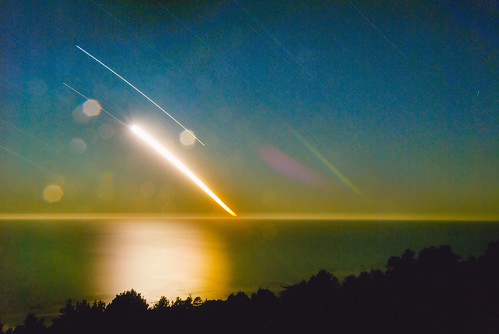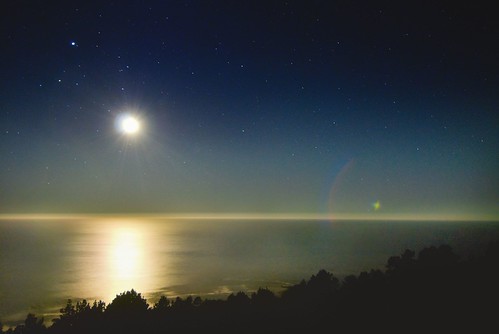There are a number of problems to solve in night photography, including seeing what you are doing, not falling off a cliff in the dark, running out of juice in your batteries, and dealing with digital noise. The payoff, if you can all manage this, includes wonderful star trails, night music, and the digital landscape of the night as human eyes have never seen it.
Like any other photograph, a photograph of the night needs to be exposed properly. To digress slightly, a proper exposure is not merely measurement of of the average amount of light falling on your subject, and setting the camera accordingly. Proper exposure involves creative assessment of whether a photo needs to be exposed for portions of the subject, and possible further adjustments to make the image lighter or darker.
The good news is that digital photography usually gives us instant feedback as to whether our exposure was at least in the right ballpark (just review the photo in your LCD).
The bad news is you often can’t review a long night exposure in real time because, well, the exposure is too long. Take a 90 minute exposure like the one below that shows the moon dropping into the Pacific Ocean. In addition to the 90 minute exposure time, it took about 45 minutes for my Nikon D200’s processor to chug through the image and save it. Even if you want to stay up all night (and I didn’t, I was fast asleep when this photo was taken), you get one crack a night. Before I could have made another exposure, the moon would have been long set and dawn would have been approaching.
Here’s where the exposure equation comes to the rescue.
View this image larger.
The exposure equation says that any given exposure (remember, an exposure controls the appearance of your photo, and is not merely a measurement of light) is set using three variables: shutter speed, f-stop (aperture), and sensitivity (ISO). To maintain a constant exposure, if you slow the shutter speed down to let in more light into your camera, you must compensate by selecting a smaller f-stop to allow less light into the camera (or by selecting a lower ISO).
Conversely, once again to hold an exposure constant, if you speed up the shutter speed, which lets less light into the camera, then you must compensate to allow more light into the camera by choosing a more open aperture setting (or by boosting the ISO).
In practice, you can use the exposure equation to run tests for long exposures like the 90 minute night exposure shown above. The method is to use a short as shutter speed as possible, with the camera lens wide open. You can then play with the ISO to get an exposure you like. A back-of-the envelope calculation will tell you how to set the camera for the long exposure.
Here’s how this method worked to find the exposure settings for image above. I set the camera to make 30 second exposures at f/4. I then tried exposures at various ISO values. The image below came out fairly well at ISO 640 (I tried ISO settings between 200 and 1,000).
Now I had my baseline. I knew two of the three variables in the exposure equation for the long-exposure photo: I wanted to take it at ISO 100 to reduce noise as much as possible, and I wanted a 90 minute exposure (the length of time from the beginning of the exposure to a few minutes after moonset). The missing variable was the f-stop (aperture), and I could use my test exposure and the exposure equation to find this value.
To go from 30 seconds to 90 minutes meant I would be letting in 180 times as much light (without other adjustments). To go down in sensitivity from ISO 640 to ISO 100 meant reducing the amount of light by 6.4 (OK, call it 6 to make calculations in the dark easier). Divide 180 by 6 and you can easily see that the aperture I selected should let in roughly 1/30 of the light as f/4.
The aperture in a lens is approximately circular, and the designation of aperture openings (f-stops) is on a logarthmic scale. Starting with f/4, each of these apertures lets in roughly half the light of the preceding aperture: f/4, f/5.6, f/8, f/11, f/16, f/22. So, 1/2 * 1/2 * 1/2 * 1/2 * 1/2 equals 1/32, which is why I chose f/22 for my exposure (at 5393 seconds and ISO 100). Since I thought the test exposure was a little too bright (the reflection of the moonlight below shows some highlight blowout), I wasn’t unhappy to cut the exposure by a little bit extra (by dividing by 6 rather than 6.4, and by cutting the aperture by 1/32 rather than my estimated 1/30).
View this image larger.
Related story: Night Music, Exposing the Digital Night.
Related site: Digital Night by Harold Davis.


Pingback: Photoblog 2.0: » Photoblog 2.0 Archive: » Star Trails
Pingback: Photoblog 2.0: » Photoblog 2.0 Archive: » North Berkeley at Night